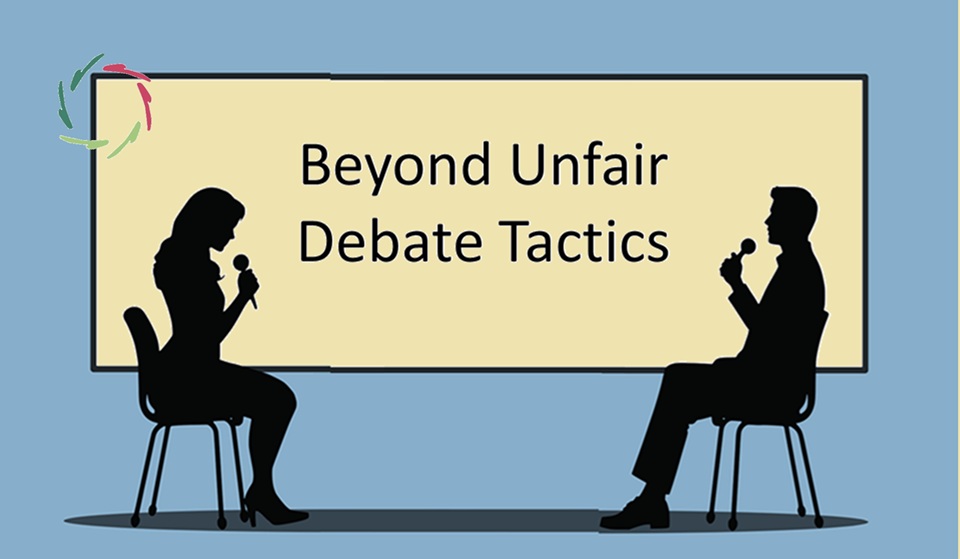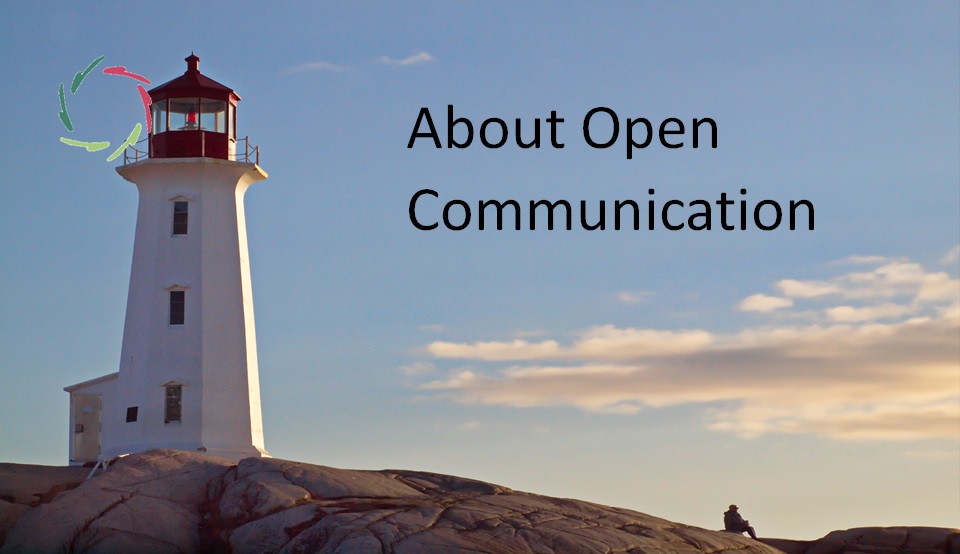Reaction vs. Communication

Most of what we call communication is, in truth, a chain of reactions. We defend, correct, or control, thinking we are relating. Yet reaction protects only what is, while communication invites what might be. This blog explores that subtle but decisive difference — one that defines our growth as individuals, societies, and a species. The Read the full article…
Beyond Unfair Debate Tactics

Unfair debate tactics may win battles of words, but never the growth of minds. This blog explores how to move beyond them. With examples, practical guidance, and links to related AURELIS writings, it shows how debate can shift from manipulation to genuine dialogue. The real victory lies not in defeating an opponent but in growing Read the full article…

Clarity Deepens Dialogue
A common assumption is that clarity and depth pull in opposite directions. In intellectual circles, spiritual traditions, and even personal relationships, there’s often a sense that the clearer something becomes, the more it loses its mystery — especially in complex or subtle conversations. But this blog explores how clarity, used respectfully, becomes the very thing Read the full article…

Lisa and Nonviolent Communication
Nonviolent Communication (NVC), developed by Marshall Rosenberg, is a structured way of speaking and listening that aims to foster understanding and reduce conflict. It emphasizes four steps: observation, feeling, need, and request — all while avoiding blame or coercion. It’s widely used in schools, therapy, peace work, and beyond. But can NVC go deep enough? Read the full article…

Why Discussion Sucks
Have you ever won a discussion? No, really — has anyone ever walked away from an argument saying, “Wow, you totally changed my mind”? Be honest. Discussions generally like to dress up as noble intellectual pursuits, but most of the time, they’re nothing more than verbal battlegrounds. Instead of inviting insight, they create division. Instead Read the full article…

How to Communicate Human Depth
In a world that often values quick answers and surface-level logic, depth can be difficult to communicate — especially to those who haven’t actively explored it. Yet, human depth is real, substantial, and present in every aspect of our lives. It shapes how we think, feel, connect, and even heal. The challenge is twofold. First, Read the full article…

Implicit Conversation
Implicit conversation occurs beneath the surface of words, shaping how we connect and resonate with others. These exchanges happen subtly, often without either party being fully aware of them. Yet their impact is profound, influencing trust, growth, and authenticity in ways that explicit communication alone cannot. From the AURELIS perspective, implicit conversation speaks to the Read the full article…

AureliZEN: 4 – The Art of Deep Communication
[For an introduction to the AureliZen series, goto AureliZEN: a Seminar Series for Deep Growth.] Communication beyond words Most people think of communication as the exchange of words. We speak, we listen, we respond. True communication is far more than this. It happens also through presence, attention, and openness. We have all experienced conversations where Read the full article…

From ‘Free Speech’ to Genuine Communication
Free speech is a cornerstone of modern societies. Yet, while its value is undeniable, it often stops short of fostering the deeper connections we crave. Genuine communication – where people truly connect, grow, and create meaning together – is a higher aspiration, one that transcends the transactional nature of free speech. How can we move Read the full article…

Talking with Non-Conscious Patterns
This is not straightforward since non-conscious patterns are, by definition, not simply available for a conscious chat. It seems like crossing a border in communication. How can one get to do what one wants to do? Or: how can one become motivated when there is no motivation? Since motivation is needed for any human endeavor, Read the full article…

Nobody Wins In Argumentation
So make sure you have a common goal with the necessary depth. In deep dialogue, everyone wins. In this case, the most important thing is to have a common goal. So make sure you have a common goal. A goal is like a mountain. When the other person is on another mountain, and you pull him off Read the full article…

Transformative Negotiation
This is a quite specific take on the concept of negotiation, with much emphasis upon humans as total persons. The explicit aim: a better world. Negotiation everywhere The stakes may be high or low. You can negotiate with your daughter about the hour she returns at night, or at the highest level between nations to Read the full article…

Coaching Note on Communication
To communicate = everything at once. Any division is artificial. Give people what they really want in your communications. In other words, try to get the colorit and respond to that, instead of responding to what you think the person might feel or might need on the surface. In the human painting, the colorit is Read the full article…

Good Communication is a Spontaneous Reaction
Spontaneous: not superficial but from the inside out. Two facts: • The non-conscious is always present and plays a significant role in whatever you do, also in the contact between a coach and a coachee. • The non-conscious reacts much faster than the conscious mind. The latter has been well investigated in the following experiment: A green Read the full article…

Watzlawick’s Axioms of Communication
… in relation to AURELIS. Paul Watzlawick (1921 – 2007) has been one of the best-known thinkers about communication. His central tenet was that a lot of communication is carried on below the level of consciousness. It happens automatically. I put his five ‘axioms of communication’ in a table and comment on them from an Read the full article…

About Open Communication
Open Communication ― encompassing the subconceptual ― is like opening doors together with another person and you don’t know what lies behind them. Please read [see: “Deep Listening”], [see: “About ‘Subconceptual’“] Towards empathy-beyond In Open Communication, Openness is empathy beyond the conceptual. It is also the aim of such empathy. [see: “Empathy in 1, 2, Read the full article…

About Communication
You have to Listen to hear it. ►►► WHY read this? In a more and more complex world, communication becomes ever more important.◄◄◄ You listen to someone. This someone talks about all kinds of things. You know what it’s about. You understand what that person is saying. But that is not enough. Do you also Read the full article…

Consciousness & Communication
Why and how has consciousness emerged? One take on this: intra- as well as extracranial communication. Why = how Organic life is not the product of an engineer who starts with the question of why he should build something, then proceeds with how he can achieve his goals. Organic life evolves from instance to instance, Read the full article…

Listening to Silence
Silence: absence of clutter in the mind. Listening to Silence within you OK. This is meditation, whether on a cushion or in the midst of a busy street… or while coaching someone or while just having an everyday conversation or while enjoying art Listening to Silence doesn’t mean that you don’t hear anything else. It’s Read the full article…

Why Friendliness Matters in Any Discussion
A lack of friendliness aborts any serious discussion. People are afraid to speak out, lest they be verbally beaten down or even expelled from the in-crowd. One needs to stand up against this. Unfriendliness is eventually ALWAYS counter-productive. In the end, good causes lose this way. The final balance is negative. What may be won, Read the full article…

Suggestion: Communication to the Subconscious
Subconscious mental processing is organic, not mechanical. Therefore it changes in a positive way through growth. Growth needs direction and freedom, a combination that is only possible through (auto)suggestion. Conceptual communication is very, well…, concept-based. It is communication with clear and distinct concepts. That’s not bad in itself. In many domains, there is no direct Read the full article…

Addictive Behavior = Communication
ADDICTIVE BEHAVIOUR = SYMPTOM = SYMBOL Addictive behavior (overeating, smoking…) is a symptom, comparable to other symptoms. So you can approach it – just like all other symptoms – in 2 ways: the symptom as a not-symbolic entity. In this case, the behavior is something that you just want to get rid of as quickly Read the full article…

Deep Listening
is probably the hardest thing to do. It’s also very important. People continuously use terms of which they think others surely know what is meant, as if these terms are exact pointers to abstract, ‘Platonian’ concepts. However: look at the brain and you notice that concepts-as-used-by-humans can never be ‘Platonian’ even if one can delineate Read the full article…

From Discussion to Conversation
This is not obvious to many people. Thereby they get into needless difficulties, trying to ‘win’ alone instead of to gain insight together. This is about people talking about some meaningful issue in a domain they both hold dear. Eventually of course, it can be any domain. A (converging) conversation is a being together, talking Read the full article…